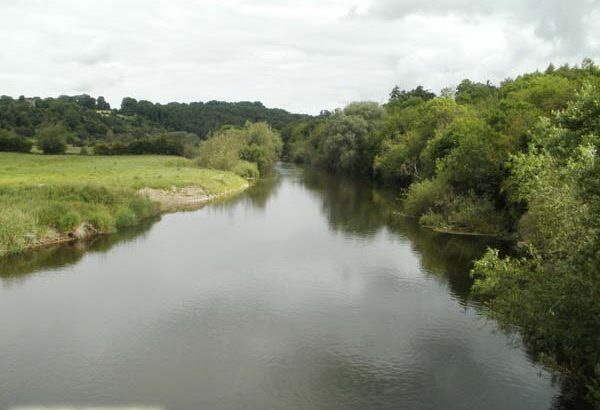
Brú na Bóinne
* aka “Palace of the Boyne” or “Bend of the Boyne” * Knowth/Newgrange, Donore, Co. Meath, Ireland * UNESCO World Heritage Site *
“Bru na Boinne” is the name of a Boyne River Valley section that is home to the World Heritage sites consisting of the Tumulus Sidhe known as “Knowth”, “Dowth”, and “Newgrange”. These monuments are the largest and one of the most important prehistoric megalithic sites in Europe that consist of a complex of neolithic chamber tombs, standing stones, henges, and other prehistoric enclosures dating as early as 35th century B.C.E. (predating the Egyptian pyramids) The Palace is centrally the name for the visitor center that is home to a museum, cafe, interpretive displays, information center, and central shuttle bus location for visitors to get to Knowth and Newgrange. It is located in County Meath near the village of Donore along the south bank of the Boyne River. The large oval stones in the water feature are 330 million-year-old naturally occurring concretions that make the site a geological attraction as well. The Sidhe/Tumulus of Newgrange and Knowth are to the north of the Boyne.
The site covers over 780-hectare acres with over 40 passage graves, prehistoric sites, henge stones, circles, and features as well as substantial Megalithic rock art. Each of the monuments is on a ridge within the river bend, with Knowth and Newgrange containing stones re-used from earlier monuments at the site. The sites were visited repeatedly and re-used during various ages such as the Bronze Age, Iron Age, and Medieval periods adding assortments of artifacts, features, and enclosures to the site throughout the years. In addition to the famous tombs/tumulus of Knowth, Dowth, and Newgrange are also the ceremonial complexes known as Cloghalea Henge, Townleyhall passage grave, Monknewtown henge and ritual pond, and the Newgrange cursus.
Newgrange stands as the central mound of the Boyne Valley passage grave cemetery. Each of these three main tumulus sites has archaeo-astronomical significance and alignments. Newgrange and Dowth have Winter Solstice solar alignments, and Knowth has an Equinox solar alignment. The complex areas are surrounded on the south, west, and east by the Boyne River, and to the north by the Mattock River.
The River Boyne
The Goddess Boann
A grandiose River in Leinster, Ireland that runs a course of over 112 kilometers (70 miles) passing by the Brú na Bóinne complex and World Heritage site, by the ancient city of Trim, Trim Castle, the Hill of Tara, Navan, the Hill of Slane, Mellifont Abbey, and the medieval city of Drogheda. It starts at Trinity Well in Kildare and flows towards the Northeast through County Meath where it empties into the Irish Sea. The river is abundant with Salmon and trout that hosts much Irish mythology on the passage of knowledge down the river. The river is notorious for its historical, archaeological, and mythological connotations. Ptolemy drew out the river in his mapping of Ireland and he called it ????????? (Bououinda). According to Irish mythology, the river was created by the Goddess Boann and the river is named after her as well as representative of her. It is also the river where Fionn mac Cumhail captured Fiontan, the Salmon of Knowledge. It is also home to the infamous “Battle of the Boyne” which took place near Drogheda in 1690. The archaeological remains of a Viking ship were found in 2006 in the river bed near Drogheda.






Discover more from The Naiads Well
Subscribe to get the latest posts sent to your email.

